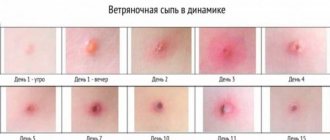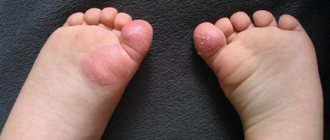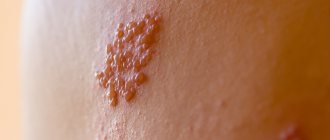How to treat chickenpox in children? (diagnosis, symptoms and treatment)
Red spots appeared on the baby's face. What is this? Allergy? Mosquito bites? What if the body temperature rises?
With questions about a disease such as chickenpox, we go to an appointment with the pediatrician at the Expert Tula Clinic, Valeria Aleksandrovna Golovko.
— Valeria Aleksandrovna, what is chickenpox and how does it manifest itself in children?
This is an infectious pathology, also known colloquially as “chickenpox”.
The symptoms of chickenpox are varied. This is the appearance on the skin and mucous membranes of a specific rash in the form of spots, nodules and blisters. Elements of the rash are found on the face, scalp, body, arms and legs. They appear one after another, i.e. First a spot or papule appears, and then a vesicle. Later, crusts form in place of the opened blisters, falling off after 1-2 weeks. At the same time, the palms and soles remain clean.
Rashes on the mucous membranes are accompanied by pain, itching and the formation of erosions and even ulcers.
Fever, malaise, and decreased appetite and sleep are also noted.
— What causes chickenpox?
Varicella Zoster virus. It belongs to the herpes viruses.
What is herpes? Candidate of Medical Sciences, dermatovenereologist at Clinic Expert Tula says:
Sheinkman Vladislav Leonidovich
— How is chickenpox transmitted?
The disease can be contracted through airborne droplets from a person with chickenpox and herpes zoster (shingles). The virus spreads when a person talks, coughs or sneezes.
— Is chickenpox a childhood disease or can adults get it too?
Children are predominantly affected, but cases of infection in adults are also common.
— Is it possible to get chickenpox again or does it only happen once?
Different situations are possible. Suppose a person was ill in childhood, but for some reason the immune system was unable to “cope” with the virus completely. In this case, the virus can remain in the so-called nerve ganglia in an inactive state. Under certain conditions, it is able to reactivate, often manifesting as shingles. This could be, for example, during exacerbations of chronic pathologies, severe stress, hypothermia, or after suffering some kind of infectious disease.
The situation described is not a re-infection. However, this is also possible in principle. This risk exists in the elderly; persons receiving chemotherapy or hormone therapy; after organ transplant operations; infected with human immunodeficiency virus. In other words, with a significant weakening of the immune system.
Is it true that unvaccinated children are the healthiest? Ulyana Vladimirovna Chemova, pediatrician, allergist-immunologist at Clinic Expert Smolensk, tells the story.
It is currently believed that the chickenpox virus does not mutate, but it cannot be ruled out that it will in the future. In this case, we can assume the occurrence of repeated infections with classic manifestations of this disease.
From personal experience: in 12 years of working in the pediatric department, I have not observed repeated cases in the same child.
— Why is it better to have chickenpox in childhood?
Because in this period of life it is much easier to bear. In people over 20 years of age, the infection is severe; after the illness, there is a high risk of complications that are dangerous not only to health, but also to life.
An example from practice: I witnessed a case of this disease in an adult woman who was sick at the same time as her child. She had a severe infection: with sharp rises in body temperature up to 40°C, severe headache, sensitivity to light and sound, hallucinations, profuse large painful rash, and swollen lymph nodes.
— Is it worth deliberately infecting a child with chickenpox?
No, you shouldn't do this. Chicken pox greatly undermines a child's immunity. Like any infection, it causes serious intoxication. The nervous system is subjected to significant stress, the cardiovascular system and musculoskeletal system suffer, and the respiratory system is affected.
How to strengthen a child's immunity? Read more
After chickenpox, a child may begin to suffer from respiratory infections more often than usual. Therefore, immediately after recovery it would be wrong to go to kindergarten or school.
How long is a person with chickenpox contagious?
It becomes contagious from the end of the so-called incubation period, that is, 2-3 days before the appearance of the elements of the rash, and remains so for 4-5 days after the appearance of the last bubbles.
— Is chickenpox a harmless disease or can it have negative consequences?
How dangerous is chickenpox for children and adults? Sometimes it leads to the development of complications. Among them, for example, are the addition of a bacterial infection to the skin in areas affected by the virus; inflammatory processes of the oral cavity, larynx, trachea, lungs, meninges and brain tissue, joints, myocardium, kidneys; swollen lymph nodes; sepsis.
If a pregnant woman becomes infected a few days before giving birth, the probability of illness in her child increases to 17%, and 30% of the sick newborns, alas, die.
— Adults who had chickenpox in childhood remember that the main problem with this disease is severe itching. How can parents help their baby relieve itching? What is the best way to lubricate a chicken pox rash?
Antihistamines and some products for external use, including those containing antiviral agents, will help relieve skin itching.
The “green stuff”, known to many, does not relieve itching, but to some extent dries and disinfects the wound, and allows you to control the appearance of new rashes.
How to properly smear a rash with chickenpox? Every morning, new blisters on the body are smeared with a solution of brilliant green. Observe the intensity of their occurrence. One day the bubbles will stop forming. From this point on, after 5 days, the infectious agent will become inactive.
— How to avoid complications with chickenpox?
To do this, you must contact your doctor in a timely manner and follow all his recommendations. During treatment, it is necessary to carefully monitor the cleanliness of the baby’s hands and the length of the baby’s nails in order to avoid contamination of the wounds on his skin.
— Tell us about the “dos” and “don’ts” for chickenpox. For example, is it possible to bathe a child with chickenpox?
“It is possible”: take water procedures even in the first days of the appearance of elements of the rash. Their absence can contribute to the transformation of the rash into abscesses due to contamination of the skin and the accumulation of bacteria on it. A short warm shower (but not a hot bath!) helps to maintain sanitary standards. After showering the baby, you should not wipe it, but gently pat the skin dry with a soft towel.
“Do not”: treat skin rashes with a 5% alcohol solution of iodine - it is irritating; violate home routine from the moment the first elements of the rash appear and for 5 days after the formation of the last blisters; use aspirin for antipyretic purposes - this increases the risk of developing Reye's syndrome (rapidly progressive cerebral edema and the development of liver complications in the form of liver failure, mortality reaches 20-30%); tear off/comb the crusts.
— Valeria Aleksandrovna, what should be the diet for a child with chickenpox?
It is recommended to drink a lot during illness. The diet should be dominated by fermented milk products, vegetables, and fruits. Fried and fatty foods should be avoided. They can contribute to increased skin itching.
— How many days does it take for chickenpox to go away?
During this disease, periods such as incubation, prodromal and the period of appearance of rash and crust formation are distinguished.
The incubation period is the period of time from the moment a microbial agent enters the body until the manifestation of the disease. Duration - 11-21 days (average 14 days).
The prodrome occurs 1-2 days before the first elements of the rash appear. In childhood, the manifestations of this period are not pronounced; in adults they are more severe (headache, pain in the lumbar and sacral area, increased body temperature are noted). Then comes a period with rashes (for both 2-5 days and 7-9 days).
In the uncomplicated classical course, recovery occurs within 10 days from the moment the first elements of the rash appear. The period of infectivity ends 5 days after the appearance of the last rash.
— Is there a vaccine against chickenpox?
Yes. Several types of chickenpox vaccine have been registered and approved for use in our country. After vaccination, lasting immunity is formed.
You might be interested in:
What will help with a cough: badger fat or mustard in socks? We treat children correctly
What to do if your child has a stomach ache?
How to save a child from hay fever?
For reference:
Golovko Valeria Alexandrovna
Graduate of the Faculty of Medicine of Tula State University in 2004.
In 2005, she completed an internship in the specialty “Pediatrics”
Currently working as a pediatrician at Clinic Expert Tula LLC. Receives at the address: st. Boldina, 74
How can you get infected?
The virus is transmitted from person to person by airborne droplets. Chickenpox penetrates through the mucous membranes of the mouth, respiratory tract, and eyes deep into the body.
The chickenpox virus is very persistent and spreads quickly. He has the ability to penetrate even into other rooms and neighboring apartments. This is why children in groups become infected with chickenpox so easily. Just one child in a group who becomes infected with chickenpox immediately becomes dangerous for the children of the entire institution.
Complications
Complications of chickenpox, even in adults, occur rarely - in approximately 5-7% of patients. The most common complication is suppuration of the rash due to the addition of a secondary infection. Abscesses and skin phlegmons form.
The second most common complication is chickenpox pneumonia. It takes a long time, is difficult, and cannot be treated with antibiotics.
The following types of complications occur very rarely:
- encephalitis - brain damage;
- myocarditis - damage to the heart;
- nephritis - inflammation of the kidneys;
- hepatitis is inflammation of the liver.
It is very rare to die from chickenpox. In almost all patients, even with severe cases, chickenpox ends in complete recovery. Lethal outcomes are possible in people with a sharp decrease in immunity.
Folk remedies
There are various ways to get rid of itching due to chickenpox and in traditional medicine:
- At high temperatures, it is advisable to drink cranberry juice, viburnum drink, rosehip infusion, and sea buckthorn tea. Strawberry juice saturates the body well with nutrients and has a pronounced antimicrobial effect.
- Bath with chamomile. 5 tbsp. Pour a tablespoon of inflorescences (dry or fresh) into a liter of hot water, bring to a boil and simmer over low heat for a quarter of an hour, strain. Add the decoction to the filled bath. The procedure takes 10 minutes, perform twice a day.
- Tea tree oil. The only essential oil allowed for direct application to the skin, without conductive oil. If you treat all elements of the rash with tea tree oil using a cotton swab, this will significantly relieve itching and scabies. This procedure promotes disinfection and speedy healing of wounds.
- Mix equally chamomile flowers, coltsfoot grass, chicory grass, calendula flowers, burdock root and immortelle flowers. Brew the prepared mixture with a dose of 40 g with half a liter of boiling water. Let it brew in a thermos for 8 hours. Take 4 times a day, a third of a glass.
- Grind the calendula herb. Heat 60 g of calendula, previously brewed in a liter of water. Pour the strained broth into the bath and bathe the patient for a quarter of an hour in the morning and evening. Do not rub the skin.
First signs
How does chickenpox start in children? First of all, the child develops:
- high temperature (up to 39.5°C),
- feverish reaction;
- moderate intensity headache;
- pain in the abdominal area (not always);
- general malaise;
- signs of intoxication (possible nausea and vomiting);
The first signs of chickenpox in children, as a rule, are indistinguishable from “normal” ARVI. The main symptom of chickenpox is a characteristic rash (first small pink spots, and then blisters with clear liquid).
Differences from other similar diseases
Chickenpox must be distinguished from diseases that occur with a vesicular rash.
Differential diagnosis table
| Sign | Chickenpox | Herpes zoster/herpes simplex | foot and mouth disease | Streptoderma |
| Source of infection | Chickenpox patient | For herpes simplex - a patient with herpes simplex. Herpes zoster is a reactivation of the chickenpox virus. | Cattle | A patient with tonsillitis, tonsillitis or a carrier of streptococcus |
| Path of infection | Airborne | Mainly contact | Through food, contact | Airborne |
| Nature of the rash | Distributed randomly throughout the body | Grouped blistering rashes on red skin background | On the hands, between the fingers, on the feet | The blisters quickly become purulent and form more often on the face |
| Intoxication | Light to heavy | With herpes simplex, there is no or mild infection. For herpes zoster, it depends on the extent of the rash | Lightweight | Lightweight |
Forecast
The prognosis for chickenpox is favorable. When observing 1145 patients aged 16-80 years, the following distribution of severity levels was observed:
- light - 7.2%;
- average - 84.8%;
- heavy - 8%.
Death occurred in four patients, giving a mortality rate of 0.34% in this study. Deaths were caused by complications - pneumonia, myocarditis, encephalitis. People with blood diseases, immunodeficiencies, and malignant tumors are at greatest risk of complications.
Sources:
- Chicken pox: adults at risk. — excerpts from the state report “On the state of sanitary and epidemiological well-being of the population of the Russian Federation.” Publishing house "Russian Doctor", November, 2022.
- Anthony J Papadopoulos, MD. Chickenpox Medication. - English-language database of current medical data Medscape, August, 2020.
- Margot L. Savoy, MD, MPH, (Lewis Katz School of Medicine at Temple University). Chickenpox vaccine. - MSD reference book, professional Russian version, July, 2022.
- Yushchuk N.D. Doctor of Medical Sciences, Academician of the Russian Academy of Medical Sciences. Chicken pox in adults. — medical scientific and practical portal “Attending Physician”, January 2000.
- Anne A. Gershon. Is chickenpox so bad, what do we know about immunity to varicella zoster virus, and what does it tell us about the future? — The Journal of infection, Jun 2022.
- Golovko M.G. Poryadina G.I. Chickenpox in adult patients on an outpatient basis. — General Medicine, April 2015.
How many days does quarantine last for chickenpox?
Doctors have given an opinion on the contagiousness of the disease: from 4 to 13 days. Therefore, epidemiologists, if it is necessary to announce quarantine measures, close educational institutions for 14 days. During this period, the child cannot be allowed into kindergarten or school.
The first 5-10 days are dangerous for others during this period. You can focus on the appearance of the rash - while it is present on the body, the virus is in active form. During this period, it is very important to limit the patient’s contact with healthy people.
Is it possible to swim if you have chickenpox?
Contrary to popular misconceptions, you can and should swim when you have chicken rash. The main thing is to take a warm bath; the water should not be hot or cold. The baby should also walk in the fresh air, but avoid contact with other children. In such conditions, treatment will be more effective, and the patient will be able to avoid complications and other severe consequences of chickenpox.
How many days does a child have fever with chickenpox?
Very often, the temperature for this disease rises during the prodromal period - when preliminary symptoms appear. The increase in temperature may not be very critical - up to about 38 degrees, sometimes with a feeling of nausea and even vomiting.
The temperature may rise and fall slightly throughout the course of the disease - with each new rash on the baby's skin. During such periods, it is necessary for the baby to drink enough fluids, rest and get a good night's sleep. It is not recommended to reduce the temperature with antipyretic drugs if it has not reached high values.
It is strictly forbidden to give aspirin to your child. However, timely prevention will help avoid complications, and even infection with chickenpox itself. The main thing is to do everything in a timely manner and completely isolate the baby from contact with patients.
Advice from Doctor Komarovsky
The most common question that concerned parents ask their favorite doctor concerns the effects of brilliant green in children with chickenpox. Evgeniy Komarovsky’s answer is unequivocal - there is no therapeutic effect from such an action, brilliant green serves only as an indicator of the period of contagiousness. Lubricating the blisters with a colored solution every day, one day mommy notices that there are no new rashes. From this moment the countdown begins for the last five days, when the baby can pose a danger to others.
The doctor draws the attention of parents to the fact that the viral infection, which is chickenpox in children, is not susceptible to antibiotics and does not require special medications during the normal course of the disease. Only in adolescence, when the disease is too severe, do doctors prescribe antiherpetic drugs.
The main advice that Dr. Komarovsky gives for mothers of sick children:
- avoid overheating, which increases itching;
- cut your nails short, wear gloves if necessary, and do your best to distract the baby from combing the bubbles;
- do not give aspirin so as not to cause liver complications;
- scratching the blisters leads to bacterial infection and the likelihood of marks for life;
- chickenpox quite strongly suppresses the immune system, so after suffering from the disease you should refrain from visiting kindergarten and devote more time to walks.
Regarding vaccinations, Komarovsky believes, sensible parents should not have any discussions. However, he reminds that vaccination against chickenpox is voluntary, so mothers and fathers will have to take responsibility for its implementation.
Features of the causative agent of chickenpox
The pathogen that causes this disease is a herpes virus. The peculiarity of this group of viruses is that they enter the human body and never leave it (or inhabit it for quite a long time). They live in nerve ganglia (nodes) and for the most part are in a “sleeping” state. But under stress, increased fatigue, after suffering from infectious diseases - with a general decrease in immunity, the virus is activated and reminds itself.
The causative agent of chickenpox is the herpes virus ||| type (Varicella Zoster). In addition to chickenpox, it also causes shingles. Since after suffering chickenpox a person develops persistent lifelong immunity, the activated virus subsequently manifests itself precisely in the symptoms of the second disease.










